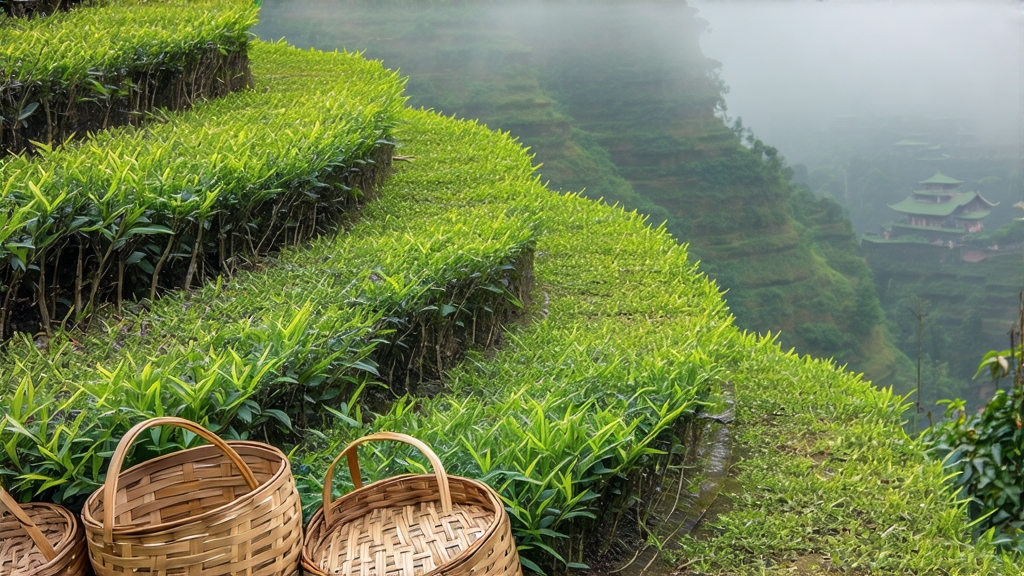
If green tea is China’s fresh-faced scholar and pu-erh its bearded sage, then yellow tea is the discreet poet-emperor who appears only when the court is quiet. Among the three authentically traditional yellow teas still produced in meaningful volume, Meng Ding Huang Ya—literally “Yellow Bud from Meng Summit”—carries the longest continuous written pedigree, yet remains virtually unknown outside the circles of Chinese tea hunters. Grown on the north-western rim of the Sichuan Basin, where the Tibetan Plateau drops into humid lowlands, this tea was already listed as tribute in A.D. 724 during the Tang dynasty, centuries before the word “yellow” was used to describe a processing family. Today it survives in micro-lots of fewer than six tonnes a year, making each sip a dialogue with mountain mists, dynastic palates, and a craft that teeters on the edge of disappearance.
- A leaf born of tectonics and monks
Meng Ding, or “Summit of the Vast Mist,” is the highest ridge of the Micang Mountains, topping out at 1 456 m. The slope catches both the warm, wet breath of the Sichuan Basin and the cold, thin air descending from the plateau, creating a 280-day fog season. The cloud acts like a giant diffuser, trimming UV intensity by 30 % and slowing photosynthesis so that amino acids, especially L-theanine, accumulate to almost twice the level found in comparable buds from lower gardens. The soil is young, volcanic loam rich in illite clay, which releases potassium in slow motion and gives the finished tea a signature “sweet spine” that lingers behind the molars.
Buddhist monks from the Woyun Temple began planting tea here in the early eighth century, selecting a small-leaf landrace that botanists now classify as Camellia sinensis var. sinensis ‘Mengdingensis’. The cultivar is distinguished by downy, almost white buds that curve like fish hooks, a trait celebrated in Tang poems as “silver frost on jade grass.” Because the mountain was declared a royal Buddhist sanctuary, every spring the abbot would seal the first 365 buds—one for each day of the year—in gold foil and courier them to Chang’an, the imperial capital. The court quickly noticed that after forty days of travel the buds had turned a pale primrose, developing a mellow, almost buttery character. Thus began the accidental discovery of “sealed yellowing,” the hallmark technique that would later define the entire yellow-tea genre.
- From green to gold: the sealed-yellowing choreography
Although yellow tea is often marketed as “green tea with an extra step,” the reality is a high-wire act in which the leaf must be coaxed to the edge of oxidation without ever declaring independence. The process unfolds in five acts, each calibrated to the mountain’s diurnal rhythm.
Withering under moonlight: Picking starts at 04:30, when the bud’s turgor pressure peaks. Leaves are spread on hemp cloth in a shaded courtyard where the temperature hovers at 18 °C and relative humidity at 82 %. Over three hours the moon’s infrared radiation gently evaporates surface moisture, reducing leaf weight by 8 %—just enough to soften cell walls without bruising.
Kill-green at the dew point: A wok heated to 160 °C receives 250 g of buds at a time. The craftsman uses only the outer 5 cm of the wok, flipping the leaves with a bamboo broom in a movement called “phoenix nods three times.” Within 90 seconds the temperature of the leaf core reaches 76 °C, deactivating polyphenol oxidase while preserving a faint rim of green around the stem. The moment a faint popcorn note appears, the batch is dumped onto a hemp mat.
Rolling in mist: While still above 50 °C, the leaves are rolled under palm pressure for eight minutes. The goal is not juice expression but rather micro-fissures on the bud’s cuticle that will later allow slow oxygen migration during yellowing.
Sealed yellowing: The critical act. The warm leaves are piled 12 cm deep inside a cedar box lined with wet rice paper. The lid is closed and weighted with river stones. Over the next 48 hours the core temperature climbs to 38 °C, then drifts back to 28 °C in a sinusoidal curve. During this interval chlorophyll degrades to pheophytin, catechins